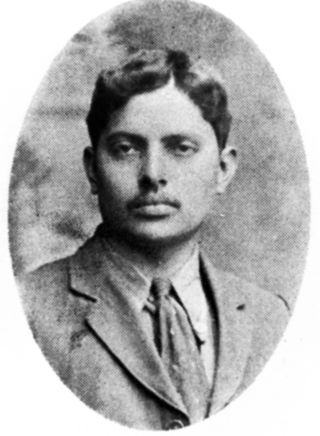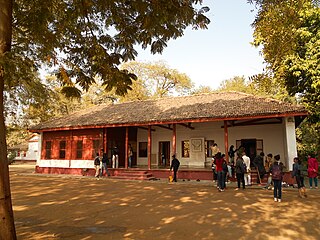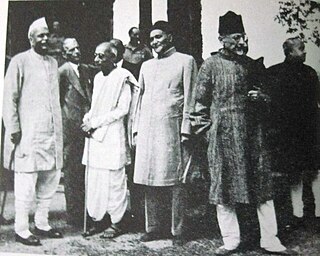
Mohandas Karamchand Gandhi was an Indian lawyer, anti-colonial nationalist and political ethicist who employed nonviolent resistance to lead the successful campaign for India's independence from British rule. He inspired movements for civil rights and freedom across the world. The honorific Mahātmā, first applied to him in South Africa in 1914, is now used throughout the world.

Mahadev Haribhai Desai was an Indian independence activist, scholar and writer best remembered as Mahatma Gandhi's personal secretary. He has variously been described as "Gandhi's Boswell, a Plato to Gandhi's Socrates, as well as an Ānanda to Gandhi's Buddha".

Gandhi is a 1982 epic biographical film based on the life of Mahatma Gandhi, a major leader in the Indian independence movement against the British Empire during the 20th century. A co-production between India and the United Kingdom, the film was directed and produced by Richard Attenborough from a screenplay written by John Briley. It stars Ben Kingsley in the title role. The biographical film covers Gandhi's life from a defining moment in 1893, as he is thrown off a South African train for being in a whites-only compartment and concludes with his assassination and funeral in 1948. Although a practising Hindu, Gandhi's embracing of other faiths, particularly Christianity and Islam, is also depicted.

Kasturbai Mohandas Gandhi was an Indian political activist who was involved in the Indian independence movement during British India. She was married to Mohandas Gandhi, commonly known as Mahatma Gandhi. National Safe Motherhood Day is observed in India annually on April 11, coinciding with Kasturba's birthday.

Harilal Mohandas Gandhi was the eldest son of Mahatma Gandhi and Kasturba Gandhi. He had three younger brothers: Manilal Gandhi, Ramdas Gandhi and Devdas Gandhi.

Sabarmati Ashram is located in the Sabarmati suburb of Ahmedabad, Gujarat, adjoining the Ashram Road, on the banks of the River Sabarmati, 4 miles (6.4 km) from the town hall. This was one of the many residences of Mahatma Gandhi who lived at Sabarmati (Gujarat) and Sevagram when he was not travelling across India or in prison. He lived in Sabarmati or Wardha for a total of twelve years with his wife Kasturba Gandhi and followers, including Vinoba Bhave. The Bhagavad Gita was recited here daily as part of the Ashram schedule.

Madeleine Slade, also known as Mirabehn or Meera Behn, was a British supporter of the Indian Independence Movement who in the 1920s left her home in England to live and work with Mahatma Gandhi. She devoted her life to human development and the advancement of Gandhi's principles.
Narhari Dwarkadas Parikh was a writer, independence activist and social reformer from Gujarat, India. Influenced by Mahatma Gandhi, he was associated with Gandhian institutes throughout his life. He wrote biographies, edited works by associates and translated some works. His writing also reflected Gandhian influence.

Sushila Nayyar, also spelt 'Nayar', was an Indian physician, a lifelong follower of Mahatma Gandhi, and a politician. She played a leading role in public health, medical education and social and rural reconstruction in India. She became Gandhi's personal physician and an important member of his inner circle. Later, she wrote several books based on her experiences. Her brother, Pyarelal Nayyar, was the personal secretary to Gandhi. In post-Independent India, she contested elections for political office and served as India's health minister.

Kalyani Nagar is an affluent, predominantly residential neighbourhood located in eastern Pune, India. It has a population of 25,272 according to the 2011 Census of India. The locality is administered by the Nagar Road-Wadgaonsheri Ward Office of the Pune Municipal Corporation.

The Simla Conference of 1945 was a meeting between the Viceroy of India, Lord Wavell and the major political leaders of British India at the Viceregal Lodge in Simla. When it was clear that British intended to leave India, they desperately needed an agreement on what should happen when they leave.

Yerawada is a neighbourhood of the city of Pune in the state of Maharashtra, India. Before that British Raj Yerawada was known as Yeraoda. Yerawada is one of the most densely populated areas in Pune. It is located at the beginning of Ahmednagar highway and also on the way to old Pune Airport at Lohagaon. This place can be reached after crossing Mula-Mutha River through Yerawada Bridge from Bund Garden.

Kirti Mandir is a small museum at the birthplace of Mohandas Karamchand Gandhi in the city of Porbandar, Gujarat, India, memorializing him and his wife, Kasturba Gandhi.

Maniben Patel was an Indian independence movement activist and a Member of the Indian parliament. She was the daughter of freedom fighter and post-Independence Indian leader Sardar Vallabhbhai Patel. Educated in Bombay, Patel adopted the teachings of Mahatma Gandhi in 1918, and started working regularly at his ashram in Ahmedabad.
Kanu Gandhi was an Indian photographer. He was a grandnephew of Mahatma Gandhi who lived with him in several of his ashrams and was a member of his personal staff. He is best remembered as Gandhi's photographer, recording many moments of Gandhi's life on film from 1938 until his assassination in 1948. Following Gandhi's death, Kanu and his wife Abha moved to Rajkot where they ran a rural centre named after Kasturba Gandhi. Abha was one of the companions with Gandhi at Birla House Delhi, when Godse shot Gandhi.

The online Gandhi Heritage Portal preserves, protects, and disseminates original writings of Mohandas K. Gandhi and makes available to the world the large corpus of “Fundamental Works” which are useful for any comprehensive study of the life and thought of Gandhiji. Gandhiji was 24 years old in South Africa "Natal Indian Congress " made in 1894.

Shobhana Ranade is an Indian social worker and Gandhian, known for her services towards her cause of destitute women and children. The Government of India honoured her in 2011, with the Padma Bhushan—the third highest civilian award—for her services to the society.
Shanti Kumar Morarjee was a noted industrialist, businessman and close associate of Mahatma Gandhi.

Mithuben Hormusji Petit was one of the pioneer Indian independence female activists who participated in Mahatma Gandhi's Dandi March. She became a recipient of India’s fourth highest-civilian honour, Padma Shri in 1961, for her social work.
Gangadharrao Balkrishna Deshpande also known as Lion of Karnataka, Khadi Bhageeratha of Karnataka, was an Indian activist who was the leader of the Indian independence movement against British colonial rule from Belgaum. He was the right-hand man of both Lokamanya Tilak and Mahatma Gandhi in succession. Deshpande considered Lokamanya Tilak as his Guru. Deshpande served as Chairman of Karnataka branch of All-India Spinners' Association, and the All India Village Industries Association for some years. Deshpande was largely responsible for the installation of Premier of Bombay, B. G. Kher.

































